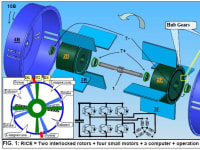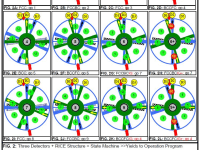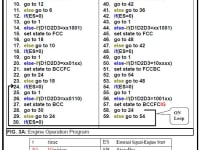RICE eliminates crank, connecting rod, cam shafts, timing belt box, valves, and the transmission of the conventional piston & cylinder. RICE replaces functions of the eliminated parts with software.
A rotor is formed when four blades (3F or 3B) are attached to a hub (2F or 2B). Four blades of front rotor (3F) together with four blades of back rotor (3B), divide the cylindrical cavity of the engine case (4B+4F) into 2 intakes, 2 compressions, 2 combustions and 2 exhausts chambers. The hub of each rotor (2B or 2F) is ratcheted (7+ or 7-) to both the engine shaft (1) and to its corresponding half-engine-case (4B or 4F). Directions of ratchets allow rotors and shaft to only rotate counterclockwise. Two electric motors (10F) engage to hub of Front rotor (2F). Two other electric motors (10B) engage to hub of Back rotor (2B). These motors are small because the highest torque they have to overcome is compression but not combustion. Three detectors (D1,D2,&D3) report detections of Front or Back rotor blades to a computer. A software program, (FIG.3), directs computer to keep engine in ON loop by controlling four motors, fuel injectors, and/or the sparkplugs.
Engine Program & Operation: The consecutive states of the rotors shown in FIG.2 have to be imposed by the program in order to run RICE. A program that is capable of achieving this task is shown in FIG.3A.
What Has Been Achieved?
1. Identical combustion to piston & cylinder also happens in RICE.
2. Computer together with 4 small motors have provided hybrid operation and have replaced the function of; crankshaft, camshafts, connecting rods, timing belt box, valves, and transmission. Moving parts produce loss. Losses of eliminated moving parts have been saved.
3. In RICE coupled combustion forces cancel the net force on the oil bearings, but in piston and cylinder combustion forces are fully enforced on both oil bearings at two ends of each connecting rod. Therefore frictional losses are lower in RICE than in piston and cylinder.
4. RICE is equipped with adaptive hybrid operation. PWM (Pulse Width Modulation) on motors, provide high torque at low rpm. Therefore transmission is not required because PWM on the motors provides the same function.
5. RICE power density is better by over an order of magnitude. Calculation proves this power density improvement alone will lead to over 10% efficiency improvement in cars, and more than that in aircrafts.
6. Timing belt and cam technique is too rigid to modulate for efficiency optimization of piston and cylinder. But the hybrid adaptive software operation of RICE can modulate combustion parameters including compression ratio to extract maximum efficiency as the rpm, temperature, and even the load change over their respective ranges.
7. RICE is cheaper to make because it has less parts.
8. Inventions (experimental aircrafts, robots, etc.) that have stayed dormant because of poor power density of conventional engines will now come to life because of RICE.
If the above outline was not satisfactory please ask for a detailed description, (sobhanis@hotmail.com).
Like this entry?
-
About the Entrant
- Name:Seyd Sobhani
- Type of entry:individual
- Software used for this entry:word, solid work, powerpoint
- Patent status:pending








